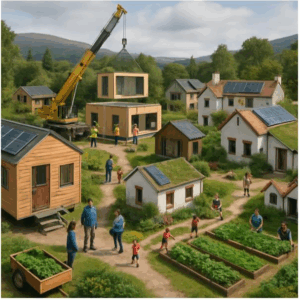Scotland’s rural communities face a unique constellation of housing challenges that threaten their long-term sustainability and cultural continuity. With 98% of Scotland’s landmass classified as rural, these communities form a vital part of the nation’s identity, economy, and social landscape [7]. However, the combination of limited housing supply, second home ownership, holiday let proliferation, and population decline creates a complex web of challenges that require targeted, innovative policy responses.
The scale of second home ownership in rural Scotland, while representing only 1% of the total housing stock nationally with 21,606 properties, has disproportionate impacts in specific rural communities [8]. In some Highland and island communities, second homes and holiday lets comprise over 30% of the housing stock, fundamentally altering the character and sustainability of these places. This concentration effect means that while the national statistics may appear modest, the local impacts can be transformative and destabilizing.
The relationship between second home ownership and local housing markets is complex and multifaceted. Second home buyers, often with greater financial resources than local residents, can drive up property prices beyond the reach of local workers and families. This pricing pressure is particularly acute in areas with limited housing stock, where even modest increases in demand can have dramatic effects on affordability and availability.
The economic impacts of second home ownership present both opportunities and challenges for rural communities. While second home owners contribute to local economies through property purchases, maintenance, and spending during visits, these benefits must be weighed against the costs of reduced permanent population, loss of local workers, and strain on local services. The seasonal nature of second home occupation can create boom-bust cycles in local economies that make business planning and service provision challenging.
Holiday let properties, facilitated by platforms like Airbnb, represent a growing component of the rural housing challenge. The conversion of residential properties to short-term holiday accommodation removes housing from the permanent rental market while potentially generating higher returns for property owners. This trend has accelerated during the COVID-19 pandemic as domestic tourism increased and remote working made rural locations more attractive to visitors.
The demographic implications of rural housing challenges extend beyond simple population numbers to encompass age structure, skills retention, and community sustainability. Young people, in particular, face barriers to remaining in or returning to rural communities due to housing costs and limited availability. This out-migration of young adults creates aging populations, skills shortages, and reduced demand for local services, creating negative feedback loops that can accelerate community decline.
The relationship between housing and employment in rural areas is particularly complex. Many rural jobs, including those in agriculture, tourism, and public services, offer wages that are insufficient to compete with second home buyers or urban commuters for housing. This creates situations where communities cannot house the workers essential for their economic functioning, leading to longer commutes, labor shortages, and reduced economic viability.
Rural housing challenges are compounded by the physical and regulatory constraints of rural development. Limited infrastructure, including water, sewerage, and transport connections, can make new housing development expensive and complex. Planning policies designed to protect rural landscapes and prevent urban sprawl, while important for environmental protection, can also limit opportunities for new housing development that could address local needs.
The Scottish Government’s Rural and Islands Housing Action Plan recognizes these challenges and proposes a range of interventions to address them [9]. The plan emphasizes the need for coordinated approaches that combine housing supply measures with policies to manage demand and ensure that new housing serves local needs. Key elements include support for community-led housing, planning policy reforms, and targeted funding for rural housing development.
Community land ownership represents one of the most promising approaches to addressing rural housing challenges. When communities own land, they can ensure that housing development serves local needs and remains affordable for local residents. The Community Land Scotland network has facilitated numerous projects where community land ownership has enabled affordable housing development that would not have been viable under conventional market conditions.
The Highlands and Islands Enterprise Agency’s work in supporting rural housing development demonstrates the potential for targeted interventions to address specific rural challenges. Their programs combine funding, technical assistance, and policy advocacy to support housing projects that serve local needs while contributing to broader community development objectives.
Planning policy reforms offer important tools for managing the impacts of second homes and holiday lets while supporting appropriate housing development. Some Scottish councils have introduced policies requiring new housing developments to include affordable housing for local residents, while others have implemented restrictions on the conversion of residential properties to holiday accommodation.
The concept of local occupancy clauses, which restrict the sale or rental of properties to people with local connections, has been implemented in some areas as a mechanism for ensuring that housing serves local needs. While these policies can be effective in maintaining local housing supply, they require careful design to avoid unintended consequences such as reduced property values or development viability.
Innovative financing mechanisms can help address the affordability challenges that prevent local residents from accessing housing in high-demand rural areas. Shared ownership schemes, community land trusts, and local housing trusts offer models for maintaining affordability while enabling local residents to access homeownership or secure rental accommodation.
The role of social housing in rural areas is particularly important given the limited private rental market and high property prices. However, rural areas typically have lower levels of social housing provision than urban areas, reflecting both historical development patterns and the challenges of developing social housing in areas with limited infrastructure and high development costs.
Rural housing associations and community-controlled housing organizations play crucial roles in developing and managing affordable housing in rural areas. These organizations often have the local knowledge, community connections, and long-term commitment necessary to develop housing that serves local needs while respecting local character and environmental constraints.
The integration of housing policy with broader rural development strategies is essential for addressing the interconnected challenges facing rural communities. Housing cannot be considered in isolation from employment, transport, education, and health services. Successful rural housing strategies must therefore be embedded within comprehensive approaches to rural development that address multiple community needs simultaneously.
Digital connectivity has emerged as an increasingly important factor in rural housing markets, particularly as remote working becomes more common. Improved broadband infrastructure can make rural areas more attractive to residents while enabling local businesses to compete in wider markets. However, it can also increase pressure from urban residents seeking rural lifestyle options, potentially exacerbating housing affordability challenges.
The environmental implications of rural housing development require careful consideration to ensure that addressing housing needs does not compromise the environmental qualities that make rural areas attractive. Sustainable building practices, renewable energy integration, and sensitive site selection can help ensure that rural housing development contributes to rather than detracts from environmental objectives.
Transport connectivity plays a crucial role in rural housing viability by determining access to employment, services, and social opportunities. Areas with good transport links to urban centers may face greater pressure from commuters and second home buyers, while more remote areas may struggle to attract and retain residents due to isolation and limited services.
The seasonal nature of many rural economies creates particular challenges for housing provision. Communities that experience significant population fluctuations due to tourism or seasonal employment need housing strategies that can accommodate these variations while maintaining year-round community viability.
Policy coordination between different levels of government is essential for addressing rural housing challenges effectively. Local authorities, the Scottish Government, and UK-wide policies all influence rural housing markets, requiring coordinated approaches that align different policy instruments toward common objectives.
The future sustainability of rural communities depends on their ability to house the people necessary for their economic and social functioning. This includes not only permanent residents but also seasonal workers, young families, and the diverse range of people who contribute to vibrant rural communities. Addressing rural housing challenges is therefore not just about housing policy but about the broader question of how Scotland’s rural areas can thrive in the 21st century.
Success in addressing rural housing challenges requires recognition that rural communities are not simply smaller versions of urban areas but have distinct characteristics, needs, and opportunities that require tailored approaches. The solutions must be as diverse and innovative as the communities they serve, combining policy innovation, community empowerment, and strategic investment to create sustainable rural housing systems.
The stakes of this challenge extend beyond individual communities to encompass Scotland’s cultural heritage, environmental stewardship, and economic diversity. Rural communities are custodians of Scotland’s landscapes, traditions, and ways of life that contribute immeasurably to the nation’s identity and appeal. Ensuring their housing sustainability is therefore an investment in Scotland’s broader social and cultural capital.






